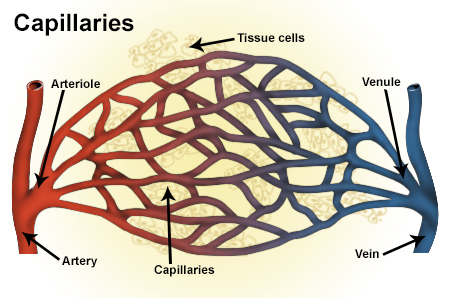The key difference between capillaries and veins is that capillaries connect arterioles and venules and involves in microcirculation while veins carry deoxygenated blood from organs and tissues back to the heart.
Usually, oxygenated blood travels through main arteries, divides into specific arteries designed for the organs and tissues, further divides into capillaries, and finally reaches the organs and tissues. Then, deoxygenated blood from the organs and tissues comes back to the heart through veins. These important parts of the circulatory system would be easy to understand if we know the differences and particular characteristics between them. Hence, this article attempts to discuss the difference between capillaries and veins.
CONTENTS
1. Overview and Key Difference
2. What are Capillaries
3. What are Veins
4. Similarities Between Capillaries and Veins
5. Side by Side Comparison – Capillaries vs Veins in Tabular Form
6. Summary
What are Capillaries?
Capillaries are the smallest functional parts of the blood circulation. Usually, capillaries interconnect venules and arterioles. Capillaries can exchange water, oxygen, carbon dioxide, hormones, nutrients, and many more between the bloodstream and the surrounding tissues.

Figure 01: Capillaries
Capillary beds cover the organs according to the function and make an efficient exchange of gases, nutrients, and wastes. Furthermore, the wall of capillaries contains only one cell layer: tunica intima. And, this endothelial cell-layered wall of capillaries facilitates the exchange of the contents.
What are Veins?
Veins are the blood vessels that carry blood towards the heart. Veins carry deoxygenated blood from the tissues to the heart and remain contracted if there is no blood inside the vessels. They run close to the skin and are generally thin structures with valves to always keep the direction of flow towards the heart. The wall of a vein consists of three layers known as tunica externa, tunica media, and tunica intima. The tunica externa is thick and has connective tissues. The tunica media consists of smooth muscles, while the tunica intima contains endothelial cells.

Figure 02: Vein
Veins of the lower part of body collect blood into one vessel called inferior vena cava, and the veins of the upper part collect into another vessel called superior vena cava; both these connect to the right atrium of the heart. About 60% of the whole blood volume of the body is contained in veins; thus, veins are also known as capacitance vessels.
What are the Similarities Between Capillaries and Veins?
- Capillaries and veins are two types of blood vessels.
- They are parts of the circulatory system.
- Moreover, they are responsible for transporting blood.
- Also, both types of blood vessels have a layer called tunica intima in their walls.
What is the Difference Between Capillaries and Veins?
Capillaries and veins are two types of blood vessels. Capillaries function in the microcirculation while veins contribute to the macrocirculation of blood. So, this is the key difference between capillaries and veins. Furthermore, the basic structural difference between capillaries and veins is that the veins are more complex and larger, while capillaries are simple and very small structures. In fact, the veins contain three different layers containing connective tissues, smooth muscles, and the endothelial layer. However, capillaries have only one layer of endothelial cells.
Moreover, the functional difference between capillaries and veins is that capillaries contribute to the exchange of gas, nutrients, waste products, hormones, and many other constituents between the bloodstream and the tissues, whereas veins help in transporting blood between different parts of the body. Importantly, the type of blood they carry is another difference between capillaries and veins. Veins except pulmonary and umbilical veins contain deoxygenated blood, but capillaries have both oxygenated and deoxygenated blood.

Summary – Capillaries vs Veins
Capillaries are the smallest blood vessels while veins are comparatively thicker blood vessels. Capillaries make a capillary bed while veins are larger vessels. The wall of the vein has three layers, while the wall of capillary has only one layer. Most importantly, veins carry deoxygenated blood from the tissues and organs to the heart while capillaries facilitate the exchange of gas, nutrients, waste products, hormones, and many other constituents between the bloodstream and the tissues. Thus, this summarizes the difference between capillaries and veins.
Reference:
1. “Capillaries: Function & Definition.” Study.com, Available here.
2. “Vein.” Encyclopædia Britannica, Encyclopædia Britannica, Inc., 7 Aug. 2013, Available here.
Image Courtesy:
1. “Capillaries” By National Cancer Institute, National Institutes of Health – (Public Domain) via Commons Wikimedia
2. “Vein (retouched)” By File:Vein.svg: Kelvinsongderivative work: Begoon – This file was derived from: Vein.svg (CC BY-SA 3.0) via Commons Wikimedia
ncG1vNJzZmivp6x7pbXFn5yrnZ6YsqOx07CcnqZemLyue8OinZ%2Bdopq7pLGMm5ytr5Wau26vwKmgpaSRp7amv4yapZ1lpqh6t7HIp6po